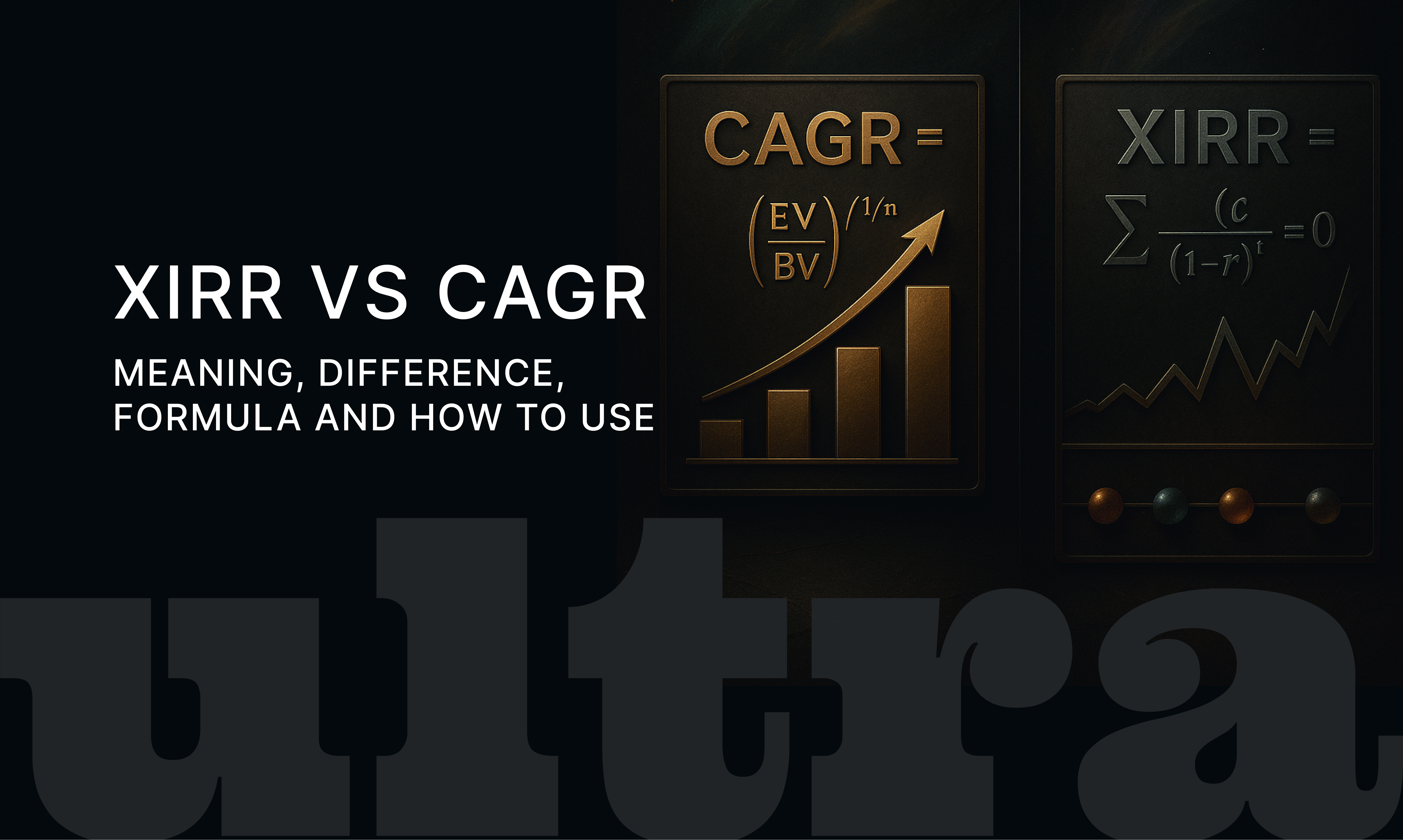XIRR vs CAGR: Meaning, Formula, Difference and How to Use
16 July 2025 · Sachin Gadekar
Know How XIRR and CAGR Differ: Which Return Metric Should You Use?

What is CAGR?
When it comes to measuring investment returns, two terms confuse many investors — XIRR and CAGR. Both help you calculate how much your money has grown, but they work differently and serve different purposes.
In this guide by Ultra, we break down XIRR vs CAGR, their meanings, full forms, formulas, when to use each, and how they apply to mutual funds.
CAGR:
CAGR stands for Compound Annual Growth Rate. It’s a measure of the annualized average rate of return for an investment over a certain period, assuming the investment has grown at a steady rate every year.
In simple words, CAGR answers the question:
“If my investment had grown at a constant rate, what would that rate be?”
CAGR Full Form:
CAGR – Compound Annual Growth Rate
CAGR Formula
The formula to calculate CAGR is:
CAGR = [(Ending Value / Beginning Value) ^ (1 / Number of Years)] – 1
For example, if you invested ₹1,00,000 and it grows to ₹1,50,000 in 3 years,
then:
CAGR = [(1,50,000 / 1,00,000) ^ (1/3)] – 1 = 14.47% per year
When to Use CAGR?
When you have a single lump sum investment.
When there are no cash flows (additional investments or withdrawals) during the period.
To compare the historical performance of stocks, mutual funds, or portfolios.
CAGR is simple, easy to understand, and perfect for measuring consistent growth over time.
What is XIRR?
XIRR stands for Extended Internal Rate of Return. It is used to calculate the annualized return when there are multiple cash flows at different times — for example, SIPs, lumpsum additions, partial withdrawals, or dividends reinvested.
XIRR means: The true annual return considering all irregular investments and withdrawals along with the time value of money.
XIRR Full Form
XIRR – Extended Internal Rate of Return
XIRR Meaning in Mutual Funds
Most investors use XIRR in mutual funds because investments are rarely lump sum. SIPs, top-ups, or withdrawals make returns uneven and scattered over time.
XIRR adjusts for the dates and amounts of each cash flow to give you the exact annual return you earned.
How to Calculate XIRR?
There is no direct XIRR formula like CAGR. Instead, XIRR is calculated using an Excel sheet or a mutual fund XIRR calculator.
In Excel, the XIRR formula is:
=XIRR(values, dates)
Values: Include investments as negative and redemption amounts as positive.
Dates: Include the corresponding transaction dates.
Example: If you invested ₹5,000 monthly through SIP for 2 years and the final redemption value is ₹1,50,000, XIRR will calculate the annualized return based on all 24 transactions and the final value.
XIRR vs CAGR: What’s the Difference?
| Parameter | XIRR | CAGR |
|---|---|---|
| Full Form | Extended Internal Rate of Return | Compound Annual Growth Rate |
| Cash Flows | Works for multiple cash flows | Works for single cash flow |
| Use Case | SIPs, lumpsums, withdrawals | Single lumpsum investments |
| Formula | Uses XIRR function | Simple CAGR formula |
| Accuracy | More accurate for real-world investments | Simple approximation |
| Example | Mutual funds, SIPs | Fixed deposits, lumpsum stocks |
Which is Better: XIRR or CAGR?
There is no better or worse — both have their purpose.
Use CAGR when your investment is simple: one-time lumpsum with no other cash flows.
Use XIRR when your investment has multiple cash flows — SIPs, partial withdrawals, or dividends reinvested at different dates.
For most mutual fund investors, XIRR is more realistic as it shows the true return on your investment journey.
XIRR vs CAGR Example
Example 1 – Lumpsum Investment:
Invest ₹1,00,000 in a mutual fund for 5 years.
Final value: ₹1,80,000.
Return:
CAGR = [(1,80,000/1,00,000)^(1/5)] – 1 = 12.47%
XIRR will also be 12.47% (as there’s only one cash flow).
Example 2 – SIP Investment:
Invest ₹5,000 monthly for 5 years.
Final value: ₹3,50,000.
Return:
CAGR does not work here because there are multiple cash flows.
XIRR = Use calculator to find the annualized return, say, around 13.5%.
How to Calculate XIRR in Mutual Funds?
Most mutual fund apps and portals automatically show your portfolio’s XIRR.
You can also calculate XIRR manually in Excel or use free online XIRR calculators by entering your transaction dates and amounts.
FAQs on XIRR vs CAGR
Q1. What does XIRR mean?
XIRR stands for Extended Internal Rate of Return. It calculates annualized returns for investments with multiple cash flows.
Q2. What is the full form of CAGR?
CAGR means Compound Annual Growth Rate. It measures average annual return assuming steady growth.
Q3. How do I calculate XIRR in Excel?
Use the XIRR formula: =XIRR(values, dates) with investments as negative and withdrawals/redemption as positive.
Q4. Which is more accurate, XIRR or CAGR?
XIRR is more accurate when there are multiple transactions. CAGR is simpler for one-time lumpsum investments.
Q5. Should I check XIRR in mutual funds?
Yes, always check your mutual fund portfolio’s XIRR to know your actual annualized returns.
Final Thoughts
XIRR vs CAGR is a classic discussion for investors. Both are important tools, but choosing the right one depends on your investment style.
For lumpsum FDs or stocks — use CAGR.
For SIPs and multiple transactions — use XIRR.
At Ultra, our experts help you understand your real returns with smart insights and tools, so you make the best investment decisions.